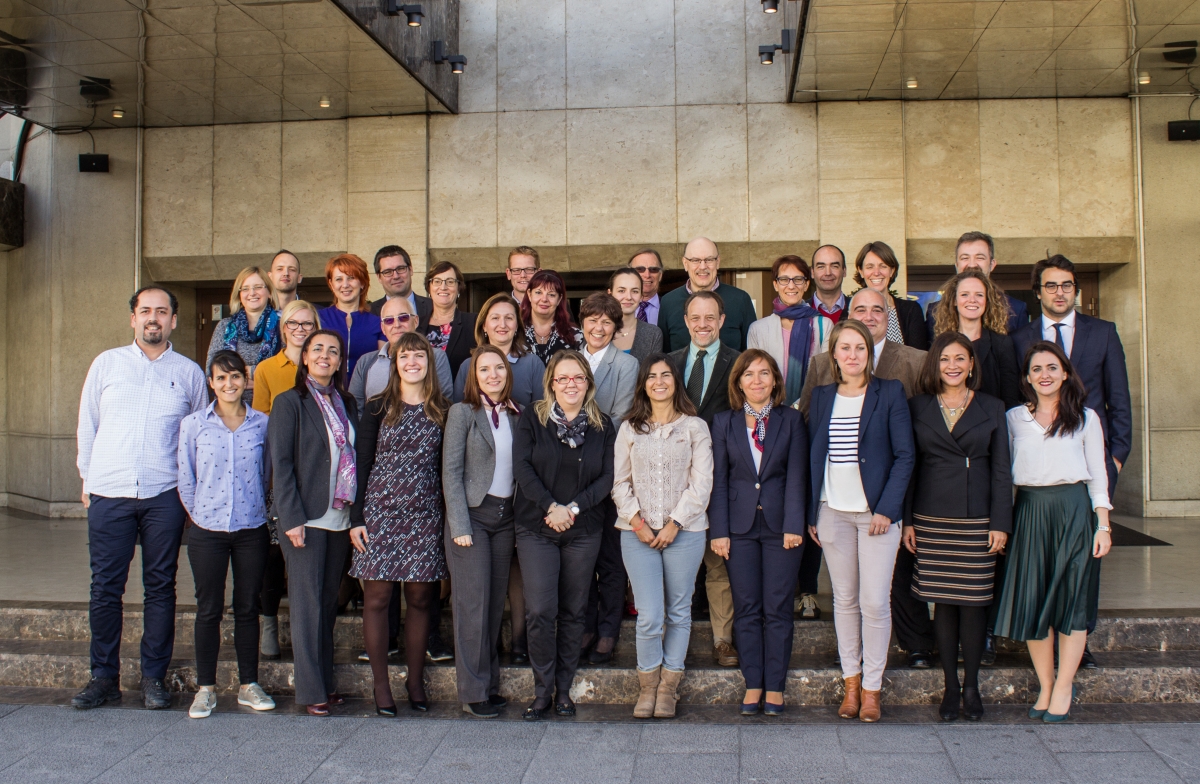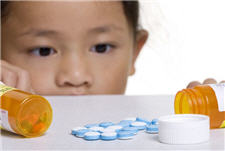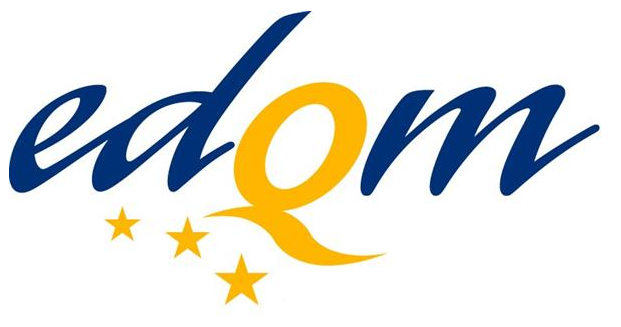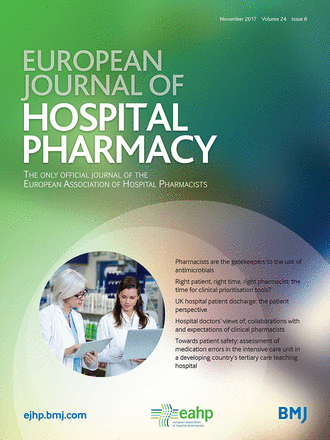EAHP EU Monitor - 7 November 2017
 The EAHP EU Monitor is a regular round up of news relevant to hospital pharmacy in Europe.
The EAHP EU Monitor is a regular round up of news relevant to hospital pharmacy in Europe.
You can subscribe to receive the EAHP EU Monitor by email HERE.

European Statements – 2nd meeting of Implementation Ambassadors
On 21st October 2017, the European Association of Hospital Pharmacists (EAHP) held the 2nd meeting of its Implementation Ambassadors. 26 of the 34 Implementation Ambassadors of EAHP's national member countries were in attendance and gave presentations to share their progress, obstacles and plans for further implementation activities.
The European Statements of Hospital Pharmacy express commonly agreed objectives which every European health system should aim for in the delivery of hospital pharmacy services. They were adopted in 2014 by EAHP's member countries and representatives from both patient and healthcare professional organisations.
EAHP is working with its network of national Implementation Ambassadors to design implementation strategies within their countries. Since the start of the implementation project in 2016, Ambassadors have raised awareness by presenting and introducing the European Statements at national events; by translating and adapting awareness materials; and through organising national workshops to discuss priorities and next steps. The specific projects that were undertaken by EAHP's member associations since the last meeting of Implementation Ambassadors were presented to the group by each country representative.
The second part of the meeting focused on the self-assessment tool which was developed by EAHP to allow individual hospital pharmacists to assess the level of Statement implementation within their countries. The primary purpose of EAHP's self-assessment tool is to help individual hospitals show progress with implementation. Users will be provided with a tailored action plan to assist them in further advancing the implementation of individual European Statements in the hospital setting. Keep an eye on EAHP's Statement implementation website where news on EAHP's self-assessment tool will be made available towards the end of this week.
If you want to learn more about what EAHP's Implementation Ambassadors are working on, please visit the Statement Implementation website. In case you have any questions about the project or if you want to help your countries and others to move towards implementation feel free to drop us an email at statements[at]eahp[dot]eu

AMR - EU scientific opinion on outcome indicators
The European Centre for Disease Prevention and Control (ECDC), the European Food Safety Authority (EFSA) and the European Medicines Agency (EMA) have jointly established a list of harmonised outcome indicators to assist EU Member States in assessing their progress in reducing the use of antimicrobials and antimicrobial resistance (AMR) in both humans and food-producing animals.
The report contains a set of primary and secondary indicators relating to antimicrobial consumption (AMC) as well as to AMR in both humans and food-producing animals. Monitoring of AMC is crucial for the prevention of AMR, since it was identified as the main AMR driver. The primary indicators broadly reflect the situation of AMC and AMR, while the secondary indicators were designed to provide information on more specific issues. These are also considered of importance for public health, but have a more restricted scope, or encompass areas that are not fully covered by the primary indicators. The indicators proposed for the different sectors should provide an overall indication of the situation regarding AMC and AMR at national level, and should support Member States in assessing their progress and the effectiveness of the measures implemented to reduce AMC and the occurrence of AMR in both humans and food-producing animals.
The primary indicator for AMC in humans is the total consumption of antimicrobials, limited to antibacterials for systemic use, expressed as defined daily doses per 1,000 inhabitants and per day. This indicator is used by both the hospital and the community sector. Two secondary indicators were identified, with the first being the ratio of consumption of broad-spectrum penicillins, cephalosporins, macrolides (except erythromycin) and fluoroquinolones to the consumption of narrow-spectrum penicillins, cephalosporins and erythromycin, in the community. The second secondary indicator is the proportion of total hospital AMC of glycopeptides, 3rd- and 4th-generation cephalosporins, monobactams, carbapenems, fluoroquinolones, polymyxins, piperacillin and enzyme inhibitor, linezolid, tedizolid and daptomycin (defined daily doses per 1,000 inhabitants and per day). It is an indicator of consumption of broad-spectrum antimicrobials used in healthcare settings.
For AMR in humans, the proposed primary indicator consists of the proportion of meticillin-resistant Staphylococcus aureus (MRSA) and 3rd-generation cephalosporin-resistant Escherichia coli (3GCR E. coli), expressed as two individual numbers. Both pathogens are of major public health importance. The proportion of Klebsiella pneumoniae with combined resistance to aminoglycosides, fluoroquinolones and 3rd-generation cephalosporins is the first secondary indicator. It was chosen to reflect AMR in the hospital sector. The second secondary indicator is the proportion of penicillin-resistant and macrolide-resistant Streptococcus pneumoniae, given as two individual numbers. This indicator covers an important cause of community-acquired infections. The third secondary indicator is the proportion of carbapenem-resistant K. pneumoniae, which is an emerging threat.
Read the report HERE

State of Paediatric Medicines in the EU
At the end of October, the European Commission presented a report to the European Parliament and the Council on the progress made in children's medicines since the entry into force of the Paediatric Regulation. The report highlights the positive advances in paediatric medicine development which thanks to the Paediatric Regulation has become an integral part of the overall development of medicines in the EU.
Since 2007, the Paediatric Regulation aims at encouraging and enabling high-quality research into the development of medicines for children; ensuring over time, that most medicines used by children are specifically authorised for such use with age-appropriate forms and formulations; and increasing the availability of high-quality information about medicines used by children. By setting up a system of obligations, rewards and incentives the Regulation tries to encourage manufacturers to research and develop medicines for children's specific therapeutic needs.
The report on the State of Paediatric Medicines in the EU showed an increase of research into paediatric medicines and that the Regulation works best in areas where the needs of adult and paediatric patients overlap. In relation to the paediatric investigation plans (PIPs) - development plans aimed at ensuring that the necessary data are obtained through studies in children, to support the authorisation of a medicine for children – it was noted that the number of agreed PIPs surpassed 1000 in 2017. PIPs were mostly completed in relation to immunology/rheumatology (14 %), infectious diseases (14 %), cardiovascular diseases and vaccines (each 10 %), while oncology (7 %) was found on the lower end of the agreed paediatric investigation plans.
Despite a lot of positive developments, the report also acknowledged that the concept of a paediatric use marketing authorisation (PUMA) – which aims at stimulating research in existing compounds that are off-patent and/or helping transform known off-label use into authorised use – has failed to deliver. To date only three PUMAs have been granted. This number clearly lies below the expected levels.
Before proposing any amendments to the Paediatric Regulation, the European Commission intends to closer investigate the combined effects of the Orphan Regulation and the Paediatric Regulation through a joint evaluation. Results of this reflection will be presented by 2019 to allow the next European Commission to take informed decision about possible policy options. This report is consequently an intermediate step in the debate on a joint vision about the future parameters for paediatric and orphan medicines.
Report available HERE
Learn more about the Paediatric Regulation HERE
 EDQM – final report of the Pharmaceutical Care Quality Indicators Project published
EDQM – final report of the Pharmaceutical Care Quality Indicators Project published
The European Directorate for the Quality of Medicines & HealthCare (EDQM) recently published its final report of the Pharmaceutical Care Quality Indicators Project. The report presents the results of a multinational validation study aimed at validating 4 basic sets of indicators to assess the quality of pharmaceutical care in Europe. It also contains the data collection forms that were developed and used in the above validation study.
Pharmaceutical care puts first the patient's quality of life through the provision of safe and efficient healthcare, while respecting the needs of healthcare professionals and society in general. The results of the specific study undertaken by EDQM should support competent authorities and stakeholders involved in the medication process in assessing the impact of pharmaceutical care and promoting the efficient and safe use of medicines.
EDQM worked since 2008 on the Pharmaceutical Care Quality Indicators Project. The 4 basic sets of indicators that were used for the assessment focused on the following pharmaceutical care areas:
- Adherence to nationally agreed clinical practice guidelines;
- Monitoring of therapeutic plans and medication safety by pharmacists through data linking and exchange of information about therapy and patient's medical condition in anticoagulant and antibiotic therapy;
- Structured patient-pharmacist consultations (chronic therapy; polypharmacy; polymorbidity) via 'My CheckList'; and
- Pharmaceutical care: special needs in certain regions.
The results indicated that the development, testing and validation of quality indicators across the 12 European countries that participated in the project are complex. However, despite the differences between healthcare systems in Europe the indicators under evaluation were considered to provide a pragmatic approach to encourage the implementation of the pharmaceutical care philosophy and working methods. Furthermore, the report highlighted that the indictors could help assure the quality of different key areas of the pharmaceutical care process.
For the delivery of pharmaceutical care and the use of the proposed indicators in daily practice it was remarked that certain capabilities need to be in place in a healthcare system. These include for instance the availability of electronic health records, advanced education and training initiatives for healthcare professionals and improved interprofessional collaboration.
Request the final report HERE (under Pharmaceutical Care)
EJHP: November edition now published 
November's edition of the European Journal of Hospital Pharmacy includes an editorial on antimicrobials, and original articles on: pharmacists' attitudes towards a pharmaceutical assessment screening tool; and, assessment of medication errors in the intensive care unit. The edition also contains a descriptive study on the impact of an integrated medicines management service on preventable medicines-related readmission to hospital.
More HERE
--------------------------------------------------------------

Consultations
EMA – Reflection paper on the use of extrapolation in the development of medicines for paediatrics
The reflection paper aims to provide guidance on the main regulatory requirements that are expected to be met for the evaluation of extrapolation approaches in development of medicines for children. However, indicating preferences for the use of particular quantitative methods to address specific objectives of paediatric development is not within the scope of this document. The principles outlined should encourage further exploration of potentially suitable methods for specific situations, and choice of strategies should be justified.
Deadline – 14th January
More information HERE
EMA – Reflection paper on the pharmaceutical development of medicines for use in the older population
The reflection paper describes aspects that medicines developers may consider when designing medicines for older people, such as selecting appropriate routes of administration and dosage forms, dosing frequency, excipients, container closure systems, devices and technologies, and user instructions in the product information. It is intended to communicate the current status of discussions on the pharmaceutical development of medicines that may be used in the older population.
Deadline – 31st January 2018
More information HERE
![]()
Upcoming events
8th and 9th November - Safer Europe Without Falsified Medicines Conference - Tallinn, Estonia
The Safer Europe Without Falsified Medicines Conference aims at understanding the current state of implementation of the safety features of medicinal products at the European Union level and in Member States; identifying the challenges for stakeholders and governments in implementing the safety features of medicinal products; as well as, developing ideas for coping with challenges.
21st November – Game Changers for better and affordable medicines for Europe - Brussels, Belgium
The 2017 Universal Access and Affordable Medicines Forum of the European Public Health Alliance (EPHA) organised under the auspices of the Bulgarian Health Ministry aims at setting out a positive agenda of actionable policy recommendations to be implemented at the European and national level. The one-day event will provide participants with stimulating and lively discussions on the hottest topics in pharmaceuticals.
22nd November – AMR and workplace learning: the case for multi-professional approach in hospitals - Brussels, Belgium
The Workshop will provide good practice examples of workplace learning aimed at tackling antimicrobial resistance (AMR) in hospitals and healthcare settings, while emphasizing the importance of inter-professional cooperation in this framework. The date chosen for the Workshop will allow to connect the event to the activities planned for the 2017 European Antibiotic Awareness Day (EAAD) and the launch of the new EAAD Toolkit for Hospital Staff.




